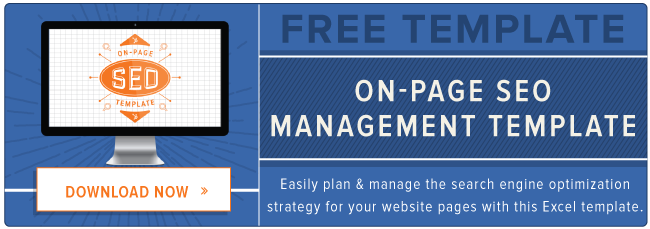
SEO can sometimes feel like it stands for "Something Extremely Obscure."
As marketers, we're responsible for staying on top of what can feel like endless Google algorithm updates. And if we fail to do so, we run the risk of not showing up in search for important target keywords.
But keeping pace with all of those changes isn't easy. Thankfully, when it comes to achieving SEO success on your website, there's one rule of thumb that remains a tried-and-tested technique: optimizing your website with relevant and targeted keywords. 
By having a well-optimized site, you'll start to see results like improved visitor quality, higher conversion rates, and in the end -- more closed customers.
In this article, I'm going to cover how to add keywords to your website once you've already completed your keyword research. So before you dive in to this post, be sure to read this awesome blog post on how to do keyword research.
Got your keywords ready? Alright. Read on to learn what on-page SEO is, where to add those keywords to your website, and how to avoid search penalties.
What is On-Page SEO?
SEO, or search engine optimization, is all about creating content, optimizing it, and promoting it. When we talk about SEO, we often talk about "on-page SEO" and "off-page SEO."
What's the difference? In short:
- On-Page SEO is what a site "says to a search engine."
- Off-Page SEO is what "other sites say" about a site.
On-page SEO, or "saying something to a search engine," means optimizing individual web pages so that they rank higher on search engine results pages. The term covers both the content itself, as well as the HTML source code -- both of which can be optimized for search.
Off-page SEO, on the other hand, refers to external ranking signals like links.
Improving your on-page SEO can help your inbound marketing efforts immensely by helping you attract the right visitors to your website. You want to optimize your pages for search engines so they can understand who you are, what you do, and what you're writing about. Again, when you improve your on-page SEO, you'll help increase the organic rank of your website on search engine results pages (SERPs).
(HubSpot customers: Click here to learn how to use HubSpot's on-page SEO tool, which is built right into the software.)
On-Page SEO Tips to Help Your Webpages Rank Better in Search
1) Start with an SEO audit of your website.
Every time you add new site content, you'll want to create that content with the specific keywords you're targeting (1–2 per individual webpage) in mind. But if you already have a bunch of web pages published, then your first step will be performing an SEO audit on your current website.
An SEO audit will give you an idea of how SEO-friendly your website is overall. That way, you can update and optimize your current content for search starting with your highest-traffic web pages. The audit will also help surface any other issues you may have, like duplicate content, so you can address them immediately and start ranking better in search.
Watch this quick video series to learn how to perform an SEO site audit in detail. It'll cover how to check whether your site is being blocked by search engines, make sure your XML sitemap is working, monitor and improve site performance, spot and remove internal duplicate content, and check your site's popularity and trustworthiness.
In short, here's what you'll need to do:
- Export all of your site pages into an Excel spreadsheet.
- Sort by the most frequently visited pages. (Learn how to sort in Excel here.)
- Decide which keyword category each one falls into, and add that category into a column beside the page name.
- Add another column in your spreadsheet to add more specific keywords that you want to add to that page. Keep in mind that they must be relevant to the content on that page, as well as terms your target audience would be searching for.
Here's an example of what this might look like:

Once you've completed this process for all of your pages (or, if you have a ton of pages, at least the most important ones), then you can jump in to your site to start adding keywords.
Here are a few other helpful resources for performing SEO audits:
- Moz: "How to Perform the World's Greatest SEO Audit"
- Search Engine Journal: "How to Perform Your First SEO Audit"
- Search Engine Land: "How To Do Your Own 5-Minute SEO Audit"
2) Add keywords (naturally) to 5 critical places on your website.
In order to optimize your pages for keywords, you'll need to, well ... include those keywords on your site. But not every placement of a keyword is equal: There are certain places on your website that are more optimal than others for on-page SEO.
Here's a list of some of the most important places to optimize for your chosen keywords on your site:
- Titles
- Descriptions
- Headings & Content
- Images Titles & Alt Text
- URLs
If you haven't optimized these sections of your site in the past, you have some work to do -- but it's up-front work that will pay off big time in the long term. To get the most bang for your buck, start with the pages that get the most traffic. Then, as you create more pages in the future, be sure to optimize as you go.
(HubSpot customers: Click here to learn how to figure out which web pages are getting the most traffic using the "Sources" report.)
Titles
Titles are the HTML element used to describe the topic of a web page. You'll find them in the title of a search engine result page (as shown below), and in the top bar of an internet browser.

Titles have a direct impact on both searcher clickthrough rates (CTRs) and search rankings. To make your title both search-friendly and click-friendly:
- Try to keep it below about 65 characters so it doesn't get cut off on search engine results pages.
- Include one of your target keywords or phrases so it's easier for searchers to identify that your results are relevant to other query -- and position these keywords toward the front of the title to lower the risk of it getting cut off on SERPs.
Descriptions
Descriptions, also known as meta descriptions, are shown in search results below the title and URL, as shown below.

Descriptions can help increase CTR, but nowadays, they actually don't have a direct impact on rankings. They're there for humans, not search engine crawlers, and you should use them to tell searchers why they should click on your result. Use one of your target keywords or phrases in your meta description so they know your content is relevant to their query, but make it attractive to the viewer, too.
Bonus: You can use this cool tool from Dejan SEO to preview what your search result would look like before deciding which description to use.
Headings & Content
It's important to use your keywords in your headings and content, as visitors are much more likely to stay on a page if they can see the terms they had searched for on it. Using keywords in your content is used by Google as a ranking factor, so doing this can help improve your SERP placement.
Just make sure you're using these keywords naturally, since Google has gotten better and better at being able to tell when people are keyword-stuffing their content. Whenever you create content, focus on what matters to your audience, not how many times you can include a keyword or keyword phrase in that content. If you do that, you'll usually find you naturally optimize for important keywords.
While it's fine to use keywords in multiple locations on your site, don't overdo it or Google will demote your web pages in search results. (And hey, no one wants to read content like that, anyway.)
Image Alt Text & Titles
You can also look at including keywords in a natural way in your image alt text and titles. Both alt text and titles are attributes that can be added to an image tag in HTML. Here's what a complete image tag might look like:
<img class="alignCenter shadow" src="image.jpg" alt="image-description" title="image tooltip"/>
An image's alt text tells search engine crawlers what an image is about, which helps it be found in search. It'll display inside the image container when an image can't be found, and it also improves accessibility for people with poor vision using screen readers.
An image title tag, on the other hand, is shown when a user hovers their mouse over the element -- kind of like a "pop-up." It won't be shown to the user when an image can't be displayed.
(HubSpot customers: Click here to learn how to add alt text and title text to your images in HubSpot.)
Adding keywords to these image attributes may seem minor, and truthfully, it isn't going to impact your search rankings as much as other things on this list. But trust us, it's worth the extra minute (if that) it takes to change the name from "IMG23940" to something accurate and descriptive.
For example, if you were to write alt text for the image below:
- Bad: alt=""
- Better: alt="puppies"
- Best: alt="golden-retriever-puppies-in-basket"
- Avoid: alt="puppy-dog-baby-dog-pup-pups-puppies-doggies-litter-retriever-labrador-wolfhound-setter-pointer-basket-wicker-basket-box-container-straw-grass-green-nature"

URLs
It's a good idea to include keywords in your URL if they accurately describe the page contents. This is particularly important for businesses that do a lot of blogging -- there's a huge opportunity to optimize your URLs on every post you publish, as every post lives on its own unique URL.
But beware: Search engines will penalize exact match domains that are keyword stuffed. So if you're thinking of starting up arizonerealestaterealtorsinarizona.com, think again. Keep it to businessname.com/topic-topic, and you should be fine.
As always, keep reader-friendliness in mind when you're creating your URLs. Overall, your URLs should make sense to humans and give them a good sense of where in your website they've landed. You should also separate words with hyphens and remove extra words (like "a" and "the") in the page part of the URL slug.

3) Learn to avoid search penalties.
There are a couple of things you should also avoid when optimizing your site for keywords, so be careful of the following sketchy SEO practices some people (mind-bogglingly) still use.
Never hide keywords.
This includes using the same color background as you do for the text, hiding them behind images, or hiding them off to the side using CSS. (I know, I can't believe I have to say it.) While this isn't as easy to catch as other black hat tactics, today's more sophisticated search engines can easily find instances of hidden keywords -- and it can result in serious search penalties.
Avoid keyword stuffing
Keyword stuffing means repeating keywords over and over again in the text, whether it's in titles, headings, descriptions, page content, URLs, or even at the bottom of a web page in very small text. Basically, when it looks like keywords have been added unnecessarily onto a web page, it's probably keyword stuffed.
Keyword stuffing is the oldest trick in the book when it comes to SEO -- and nowadays, search engines have been developed specifically to detect it. Not only does it look spammy, but it's not approved by search engines and will result in penalties.
Don't force keywords where they don't belong.
This isn't quite the same as stuffing a lot of keywords into a post. This is more about not forcing a keyword in -- even if it's just one -- if it doesn't belong, contextually speaking. If you can't figure out a place to put a keyword in a piece of content, it's often a sign the content isn't that well-aligned with what your personas need, anyway.
Remember, SEO is not about incorporating as many keywords as possible. It’s much more about picking content topics relevant to your target audience.
4) Promote a good user experience.
The most important thing to consider is your visitor's user experience. While optimizing your website for an algorithm sounds purely scientific, remember that the goal of search engines is the deliver the best experience possible to their end-users: searchers. If you keep that goal in mind with your SEO strategy, you'll be more likely to make good choices. Think about humans first and search engines second, and you'll be alright.
We know you're a busy marketer with a lot of things on your plate. SEO need not fall to the bottom of your priority list because of lack of knowledge -- or, worse, fear you're doing it wrong. We hope this was a helpful starting-off point for your on-page SEO efforts. Happy optimizing!
Editor's Note: This post was originally published in February 2014 and has been updated for accuracy and comprehensiveness.
from HubSpot Marketing Blog http://blog.hubspot.com/marketing/seo-site-keyword-optimize-ht
Via http://blog.hubspot.com/marketing/seo-site-keyword-optimize-ht


No comments:
Post a Comment